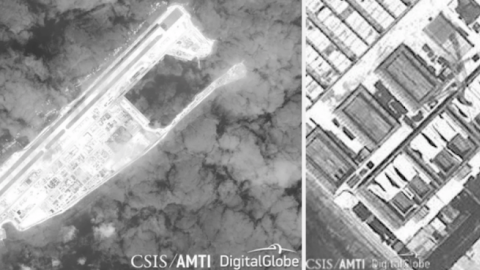China has once again raised the stakes in one of the world’s most fiercely contested waterways Sea — this time, for the first time, on Donald Trump’s presidential watch.
New satellite photos have revealed that China is building surface-to-air missile (SAM) facilities on Subi, Mischief, and Fiery Cross Reefs in the South China Sea’s Spratly Islands. These are part of the network of artificial islands, or the Great Wall of Sand, that China has been building in the Spratlys since 2014. The construction project has now grown to more than 3,000 acres and includes air strips and hardened structures for military aircraft, mobile anti-aircraft batteries and radar units, and hardened sites for aircraft.
In an NRO article in December, I predicted that the stage was being set for installing SAM batteries as the next step to militarizing the Spratlys — something China’s president, Xi Jingpin, swore in 2015 would never happen. Now it’s coming to pass. All of it is part of China’s strategy of imposing its claims of sovereignty over South China Sea — by force if necessary. The key question is, What can the Trump administration can do about it”
President Obama’s two years of inaction systematically demoralized our allies in the region, including Japan, which is not one of the five other nations with claims in the South China Sea. Japan does fear, however, that unless the U.S. takes a stronger stand, China will do the same on contested islands in the East China Sea.
Trump has already said he will. In their most recent meeting, he told Japan’s premier Shinzo Abe that he stands “100 percent” behind Japan, including in the East China Sea. Secretary of State Rex Tillerson has said that China’s buildup in the South China Sea must be stopped; he has compared it to Russia’s annexation of Crimea.
But what can the Trump administration actually do, short of taking military action such as blockading the Spratlys? Any action in that vein would run the risk of escalating into a conflict no one wants and no one gains from.
There are three steps this administration can take, starting this week.
1) China’s installation of SAM sites is clearly the final step toward declaring an Aircraft Defense Identification Zone, or ADIZ, which allows a country to monitor and control foreign aircraft entering airspace it considers part of its national territory. China has already declared such an airspace in the East China Sea, which neither we nor Japan recognize. We should state publicly that we will not recognize a Chinese ADIZ in the South China Sea, either, and that we and other countries will feel free to conduct overflights in the Spratlys and South China Sea as we normally do. If China then wants to play chicken with U.S. air assets, including military aircraft, operating in an illegitimate ADIZ, that will very quickly become their problem, not ours.
2) We should summon an international conference of states bordering on the South China Sea, including the five other claimants to the territory there (Philippines, Vietnam, Taiwan, Malaysia, and Brunei) as well as Australia and Japan, to discuss a situation that has reached crisis proportions and that now demands a concerted multilateral response.
3) Most important, it’s time to recognize that the key leverage the U.S. has over China’s strategy in the South China Sea is Taiwan. In some regards, President Trump may have been too quick to concede a “one China policy” with President Xi two weeks ago. That’s a concession best made in a face-to-face summit, not over the phone — if at all at this point. It’s what’s clearly encouraged Beijing to think that Trump may be, like Obama (in Mao’s phrase), a paper tiger.
Trump doesn’t have to reverse his statement, but he should make it clear that the United States is going to take a very broad interpretation of our remaining treaty obligations toward the democratic island nation of Taiwan. The U.S. suspended or revoked too many of these obligations in order to appease Beijing in the 1970s.
The USS Carl Vinson, for example, sailed to the South China Sea this past weekend, as a warning to China. Let it make a courtesy call in Taipei, the capital of Taiwan. Also consider plans for an official visit by America’s Commander in Chief of Pacific Command Admiral Harry Harris, who understands only too well the growing China threat (and who actually coined the phrase “Great Wall of Sand”).
Taipei is understandably nervous about doing anything that might provoke Beijing, and care is required in handling the U.S.–Taiwan relationship — something this administration doesn’t always seem ready to show. But Taiwan has a stake in the contest over the future of the South China Sea and could be a key strategic ally in limiting China’s ability to generate mischief in those waterways through which one-third of the world’s annual maritime traffic flows.
Douglas MacArthur famously described Taiwan as an “unsinkable aircraft carrier” in the Pacific. It could also be America’s unsinkable fulcrum for leverage in dealing with China, now and in the future.
















